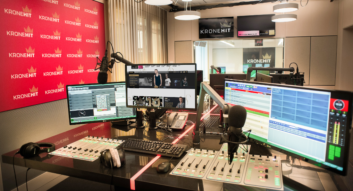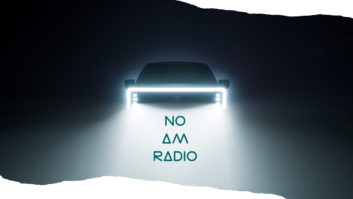LONDON — There is no shortage of news reports bemoaning broadcast radio’s demise at the hands of streaming media.

A case in point: “Since 2010, around 840,000 15 to 24-year-olds have switched off for good, according to research from Enders Analysis,” reported The Guardian newspaper in an article with the witty headline, “Is streaming killing the radio star?” “And among the 6.5 million or so who do still tune in, the amount of time they spend listening has plummeted 29 percent between 2010 and 2018. The problem is even more acute at the BBC, with total listening hours among 15 to 24-year-olds falling 40 percent over the same time period.”
This sense of doom and gloom was reflected by Bob Shennan, the BBC’s director of radio and music, in a May 15, 2018 speech to the Radio Academy. “Streaming services are the new best friend to music. After all they have transformed the financial fortunes of a sector that was on its knees,” he said. “But they have set their sights on radio.”
Worse yet, “Whereas in years gone by my predecessors would today be eyeballing their competition across the United Kingdom radio sector, our competition isn’t even based on this island,” said Shennan. “The new competitive set is global.”
NOT NECESSARILY THE BAD GUY
Based on the warnings about streaming media such as those delivered above, it is easy to assume that listeners accessing audio content by the web is bad news for broadcasters.
But this isn’t actually the case, because streaming media is merely a delivery platform that is indifferent to the content is carries. In other words, streaming media itself is no more an enemy of broadcast radio than it is a friend: It all comes down to the specific content being streamed, and how that affects broadcast radio’s audience share.
This point is not lost on James Cridland, radio consultant.
“Are Spotify, Deezer, Pandora or other streaming music operators hurting radio? Yeah, of course they are — if your radio station just plays music,” Cridland told Radio World. “I can get a much better ‘10 great songs in a row’ from Spotify than I ever could from your station — with the benefit of personalization and skipping songs I don’t like. The same goes for YouTube, which gives a pretty good music service these days too, and YouTube’s free.”

“If you are a radio station and you don’t offer anything beyond ‘10 great songs in a row,’ then the growth of these streaming services should concern you,” he noted. “They account for a significant chunk of at-work listening; including mine.”
CAPTURING APP MAGIC
On the flip side, are TuneIn, Radioplayer, and other websites that aggregate and stream radio stations hurting broadcast radio? “Absolutely not,” replied Cridland.
“First, it’s another place for your radio station to be found. Second, aggregators like TuneIn or Radioplayer get your station into places that you, yourself, can find much harder to reach. Everything from smart speakers to better experiences in the car are all enabled by aggregators like this.”
The takeaway: Streaming media can be a boon to broadcast radio if their stations are easily available on TuneIn, Radioplayer, and other aggregator sites; and made accessible online and via apps to people at their computers, in cars, and on their smartphones.
Radio apps are increasingly popular with listeners in general, and particularly the Millennials that broadcasters are so desperate to reach.
Don’t take our word for it; check out what’s happening in the U.K. according to RAJAR [Radio Joint Audience Research]; the country’s official radio audience measurement agency.
According to RAJAR’s Spring 2015 MIDAS [Measurement of Internet Delivered Audience Services] survey, 19 million people (35 percent of the U.K.’s population) had downloaded radio apps. This included 4.1 million (49 percent) of 15–24-year-olds and 4.3 million (49 percent) of 25–34-year-olds.
AN APP MASTER
Jump ahead three years to RAJAR’s Spring 2018 MIDAS: Now 28 million people (52 percent) of the U.K. population) had downloaded radio apps. This total includes 5.1 million (64 percent) of 15–24-year-olds) and 6.2 million (69 percent) of 25–34-year-olds.
On the good side, radio apps (those delivering broadcast radio streams via the mobile internet), are gaining ground among U.K. listeners of all ages; including the much-sought-after Millennials. On the bad side, listeners can also tune into streamed radio using “aggregator apps” offered by TuneIn and Radioplayer; apps that let people easily tune to other stations besides your own.
Don’t lose heart: “If you want your listeners to come to your station’s app, then they will,” said Cridland; “but only if you make your app better than the aggregator apps, and at least maintain ‘feature parity’ with them.” In other words, a broadcaster’s radio app has to offer “all the bells and whistles” that are in TuneIn’s app, he said. “Got Chromecast? Android Auto or Carplay functionality? Does it work with your watch? Listeners want all this stuff too.”
“Do your own apps hurt ‘radio’?” he queried. “Only if you believe radio is defined by having a transmitter in a field.”
[Read: Survey Says…Radio Is Still Going Strong, But Digital Is Moving Up]
Austrian Top 40 station Kronehit has embraced James Cridland’s approach and then some, by ensuring that their free Kronehit app is not only as better than TuneIn’s but also able to match the music selection features offered by Spotify and Pandora.
MAKE STREAMING YOUR FRIEND
Specifically, Kronehit’s radio app allows listeners to skip songs they don’t like, just as they can with Spotify. When the replacement song has finished, Kronehit’s streaming feed automatically rejoins the show in progress; keeping listeners locked into Kronehit’s unique broadcast environment.
“We let people jump over the song, while remaining with the live feed,” said Rüdiger Landgraf, Kronehit’s program director. “In this way, they don’t lose out on our live weather and traffic information; something that makes broadcast radio so much better than automated streaming media. Live content like this is what makes broadcast radio so much better than music streaming. With the Kronehit app, our listeners get the best of both worlds.”
If there’s a moral to this tale, it is that streaming media can be broadcast radio’s salvation, rather than the cause of its demise.
The key to attaining this salvation is for broadcasters to go all-out in replicating the very best features that streaming media web sites and apps have to offer, and then topping them with the live information and personality-driven content that radio excels at.
James Careless reports on the industry for Radio World from Ottawa, Ontario.




